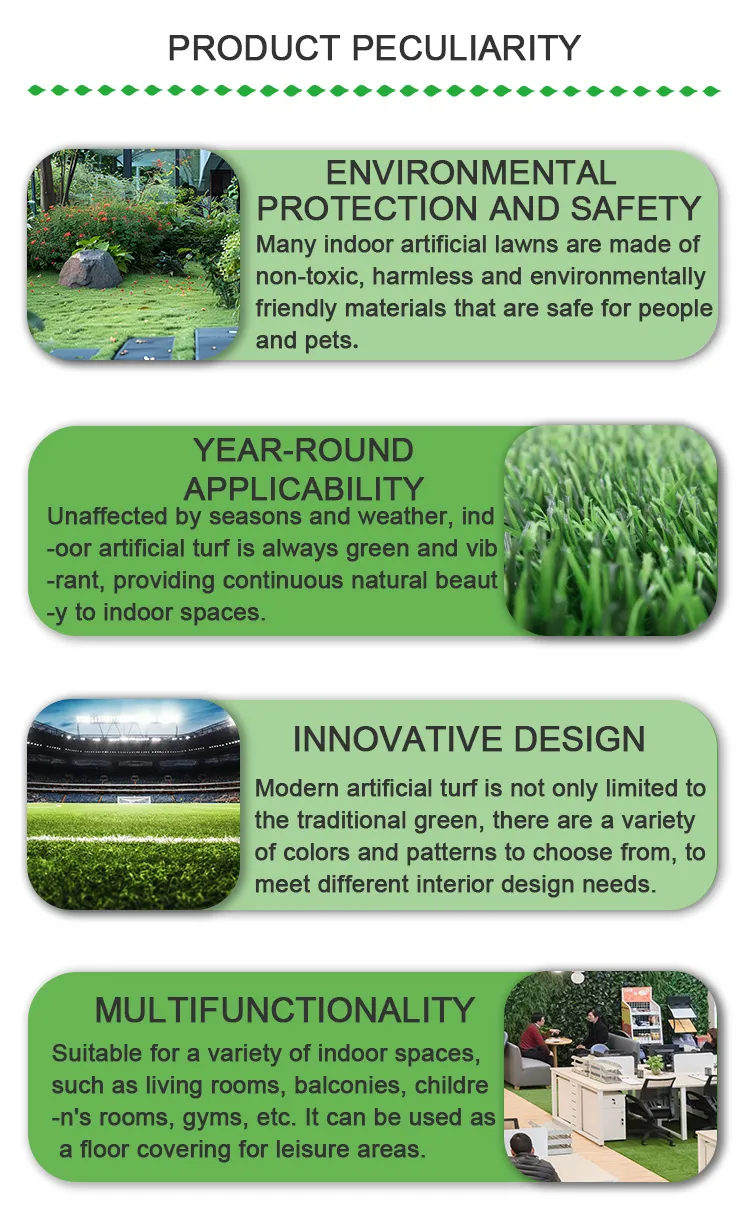
- Afrikaans
- Arabic
- Belarusian
- Bengali
- Czech
- Danish
- Dutch
- English
- Esperanto
- Estonian
- Finnish
- French
- German
- Greek
- Hindi
- Hungarian
- Icelandic
- Indonesian
- irish
- Italian
- Japanese
- kazakh
- Rwandese
- Korean
- Kyrgyz
- Lao
- Latin
- Latvian
- Malay
- Mongolian
- Myanmar
- Norwegian
- Persian
- Polish
- Portuguese
- Romanian
- Russian
- Serbian
- Spanish
- Swedish
- Tagalog
- Tajik
- Thai
- Turkish
- Turkmen
- Ukrainian
- Urdu
- Uighur
- Uzbek
- Vietnamese
synthetic turf for playground
Dec . 13, 2024 20:33 Back to list
Synthetic Turf for Playgrounds A Safe and Sustainable Choice
In recent years, the use of synthetic turf in playgrounds has emerged as a popular trend among schools, municipalities, and private establishments. Unlike natural grass, synthetic turf offers a range of benefits that are particularly appealing for recreational spaces designed for children. This article explores the advantages of synthetic turf for playgrounds and discusses why it is becoming the preferred choice for outdoor play areas.
One of the most compelling reasons to choose synthetic turf for playgrounds is safety. Traditional grass can become muddy and slippery when wet, leading to dangerous play conditions that may increase the likelihood of injuries. Synthetic turf, on the other hand, is designed with advanced drainage systems that ensure water quickly evaporates, keeping the surface dry and safe for children. Additionally, modern synthetic turf is often installed with shock-absorbing infills or padding underneath, providing an additional layer of cushioning against falls, which is critical in playground environments where children can be prone to trips and slips.
Another major advantage of synthetic turf is its low maintenance requirements. Natural grass demands ongoing care—mowing, watering, weeding, and fertilizing—which can be time-consuming and costly. In contrast, synthetic turf eliminates these needs. Once installed, it requires minimal upkeep, primarily consisting of periodic brushing and occasional cleaning to remove debris. This can save both time and money over the long term, allowing schools and community organizations to allocate resources elsewhere, such as enhancing programming or improving facilities.
Durability is yet another reason why synthetic turf is a logical choice for playgrounds. Unlike natural grass, which can be easily damaged by heavy foot traffic, weather, and pests, synthetic turf is designed to withstand rigorous use. It remains vibrant and intact regardless of varying weather conditions, from scorching summer heat to freezing winter temperatures. This durability means that playgrounds can remain in use throughout the year, providing children with a safe space for play regardless of the season.
synthetic turf for playground

Environmental considerations also play a crucial role in the decision to use synthetic turf. Many modern synthetic turf products are made from recycled materials, helping to reduce plastic waste. Moreover, since synthetic turf does not require pesticides, herbicides, or fertilizers, its presence can lead to healthier soil and water systems. By reducing the need for chemical treatments, communities can ensure a safer environment not just for children, but also for local wildlife and ecosystems.
Furthermore, synthetic turf can be engineered to be more eco-friendly than traditional grass. New technologies are available that allow for irrigation-free solutions, generating less water waste compared to maintaining a natural grass lawn. The longevity of synthetic turf also means that it can last for 15 to 20 years, which ultimately results in less frequent replacements and lower overall environmental impact.
However, it is important to note that while synthetic turf has many benefits, there are some concerns that need to be addressed. For instance, some people worry about heat retention on hot days, which can make the surface hot to touch. To counter this, manufacturers are developing turf that incorporates cooler materials, and providing shade options can also help mitigate this issue. Additionally, there is ongoing research into the safety of materials used in synthetic turf, particularly regarding the infill materials, to ensure they are non-toxic and safe for children.
In conclusion, synthetic turf presents an innovative and practical solution for playgrounds, with multiple advantages that contribute to child safety, ease of maintenance, durability, and environmental sustainability. As communities continue to prioritize creating safe and engaging play environments for children, the adoption of synthetic turf is likely to rise. By making informed choices regarding playground surface materials, we can ensure that children have access to safe and enjoyable spaces for play, fostering their physical well-being and development for years to come.
-
The Benefits of Artificial Turf for Indoors
NewsJul.15,2025
-
How Artificial Grass Suppliers Ensure Quality Products
NewsJul.15,2025
-
Artificial Grass and Pets: A Space for Relaxation
NewsJul.08,2025
-
Balcony & Outdoor Decoration with Artificial Grass
NewsJul.08,2025
-
Best Indoor Artificial Grass for Home
NewsJul.07,2025
-
Best Pet Turf for Dogs: Safe & Durable Artificial Grass Options
NewsJul.07,2025
Products categories









